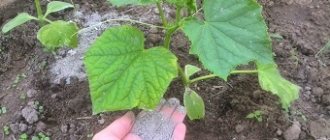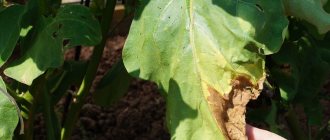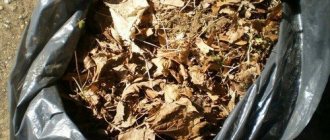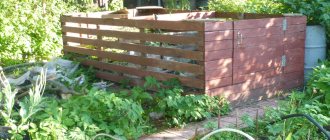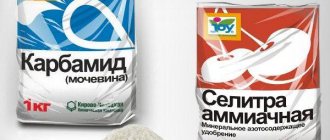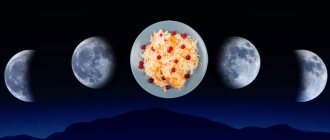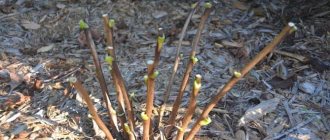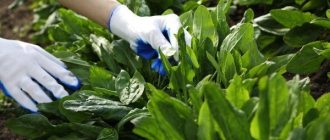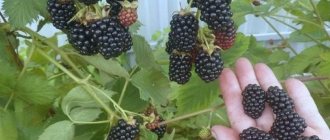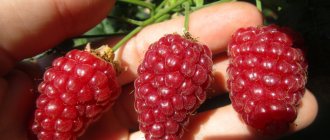Fallen leaves can be a good material for mulching a garden or vegetable garden.
However, they must be used correctly , otherwise such mulch will cause a lot of harm instead of benefit.
We have already written about the general principles of mulching here, but now we will talk about the differences that appear when using fallen leaves as a mulching material.
Features of rotting leaves
Compared to wood chips, sawdust or shavings, the sheet has a huge area, so its rotting proceeds somewhat differently than wood processing waste.
This material has a very soft, fragile structure, which further loses strength under the influence of moisture, as well as when the temperature passes through zero.
Part of the foliage becomes food for bifidobacteria and fungi , which convert any organic matter into humus. The remaining part of the leaf mass becomes food for earthworms and various insects that loosen the soil.
In addition, the green mass contains less polysaccharides, that is, cellulose, and also has almost no lignin, so the amount of polysaccharides that ensure plant growth is slightly less than in humus from wood waste.
At the same time, the high content of microelements makes such humus more balanced, so adding nitrogenous fertilizers along with it eliminates this drawback.
Another advantage of leaf humus is that it is more effective at loosening the soil than humus from wood waste . This is caused by the structural features of the foliage.
What else can you do with leaf litter?
Fallen autumn leaves are also used for other purposes: • if you do not want to burn the green mass, rake it onto an unused plot of land to prevent the spring growth of weeds, as well as weathering and washing away the top layer of soil. In spring, transfer the leaves to your compost pile; • shred the leaves in a garden shredder and add to your compost with vegetable and garden waste; • move the leaves to the far end of the site, especially if it is located near the forest. Hedgehogs like to spend the winter in such piles.
As you can see, even fallen leaves in autumn can be used. They cannot be used to produce nutritious fertilizer for plants, but they can be used to create a good means of increasing soil fertility.
Is it possible to cover a vegetable garden?
You can cover your garden with fallen leaves. Due to the low density of this material, you can pour a layer 15–30 cm thick and it will not damage the soil or plantings.
must with caution where perennial plants , because in the process of converting organic matter into humus, acids are released that can damage the trunks.
It is advisable to wrap the trunks of plants with plastic film . It cannot be pressed tightly against the trunks; it is necessary to ensure free air movement.
You can also put a protective cover made of a plastic bottle on them.
it is advisable to dig them up immediately after the snow melts , and plant seedlings or seedlings after 1–2 months.
In this case, the soil structure destroyed as a result of digging will have time to recover, and earthworms and other important inhabitants will return to it.
In addition, during this time, many useful substances from the humus will go into the soil and make the entire volume of soil more fertile.
Using mulch from fallen leaves in the garden is no different from mulching beds.
If the garden is not planted with winter varieties of plants, then it is covered with a layer of fallen leaves, and after the snow melts, it is dug up and allowed to settle for 1–2 months.
You can do without digging, but in this case the plantings should be planted not in dug holes, but in holes pierced with a shovel handle, and sprinkled on top with a mixture of garden soil and humus from fallen leaves.
This method of planting , unlike digging, does not destroy the soil ecosystem , so seedlings or seedlings can be planted 1–2 weeks after the snow melts, when the soil has warmed up a little.
What are the benefits of leaf humus?
Fallen leaves, unfortunately, are practically devoid of nutrients, and therefore are of little use for fertilizing the soil and saturating it with microelements. But you can’t just leave them to rot on the ground - diseases develop in rotten leaves and pests infest. Therefore, litter often serves as the basis for leaf humus, which gardeners use for the following purposes:
- soil conditioning - when saturated with humus, moisture is retained in the soil longer, especially in the area of the root system, making it easier for plants to tolerate drought;
- earthworms hatch in rotted litter . These are the main assistants to gardeners and gardeners. They improve air and water exchange in the soil;
- leaf humus acidifies the soil , which has a positive effect on the development of fruit trees: apple trees, plums and pears. Sometimes it is used for indoor plants: hydrangeas, camellias, ferns and rhododendrons;
- the rotted substrate is used as mulch . Cucumbers, tomatoes and other vegetable crops respond especially well to such shelter.
If you decide to prepare enough substrate, go to the forest for a portion of leaves
Is it possible to add fallen leaves to garden beds along with other fertilizers?
Fallen leaves can be added to the beds together with any other fertilizers , if the peculiarities of its effect on the soil or plants are taken into account.
When organic matter rots, the soil loses nitrogen and also becomes more acidic, so the fertilizer complex must not only fill the soil with nutrients, but also compensate for the loss of nitrogen , as well as changes in acidity.
It does not matter in what state (whole or chopped in a garden vacuum cleaner with a mulching function) the foliage ends up in the beds. After all, it is not the size or shape that is important, but its chemical composition and the processes that occur during decay.
Compost from a bag
There is another way to compost fallen leaves: pack them in plastic garbage bags (preferably black, so that they are better warmed by the sun's rays).
Pour the contents with ash from the stove, spill with water and tamp down properly. Place the bags in the back of the area so that the sun hits them, and shake occasionally if possible.
Some gardeners suggest opening them and using young compost in the spring, but it makes sense to keep the bags unopened until the fall so that the humus can ripen properly. Then you will receive an excellent foliar fertilizer that can be used not only in your garden, but also for planting indoor plants.
Article on the topic
More humus, less chemicals. An expert on how to create a super garden
Mulching the garden and lawn
around trees without the restrictions used when mulching beds, because the trees are protected by strong bark that can easily withstand the effects of acids.
Care must when moving along paths or between rows, because the foliage quickly becomes limp and turns into a slippery mass. Therefore, it is necessary either not to fill up the paths/rows, or to lay boards on top of the mulch and walk on them.
to add nitrogen fertilizers and microelements along with leaf mulch , as well as regulate changes in acidity by adding lime or dolomite flour .
When mulching lawns populated with perennial grasses or flowers, the stems of which are completely cut off before frost, it is enough to cover the lawn with a layer of fallen leaves 10–20 cm thick .
In the spring, after the snow melts, plant stems will easily make their way through a thin layer of rotted foliage, and within a year, insects and earthworms will completely recycle the remaining mulch.
As a result of their vital activity, enriched and loosened soil with high water permeability will be obtained. However, this does not eliminate the need to apply fertilizers, including microelements, because in the wild their role is played by animal excrement and decomposing corpses of various living creatures.
If bushes and flowers grow on lawns, the stems of which are not removed before winter, then they should not be mulched with fallen leaves, because acids and other substances produced by microorganisms will damage the plant stems .
In this case, it is better to use crushed leaf mass , which is obtained after removing leaves with garden vacuum cleaners with a mulching function.
The advantage of the crushed mass is that it is easier to lay it around the stems so that the mulch does not touch them . If there is no such device, then it is advisable to protect the stems with polyethylene or plastic from bottles.
Readiness of humus for use
The leaf substrate can be applied 0.5-2 years after planting. The timing is determined depending on the density of leaves and tree species. Young humus becomes like a homogeneous dark mass with “skeletons” of leaves, small sticks and unprocessed residues.
In the spring, the substrate is added to the soil before planting in open ground or in flower containers, buried under perennial plants, used as mulch, sprinkled on holes in the lawn and added to compost. Often such humus is used for germinating seeds and growing seedlings. And when mixed with garden compost and fine sand or loam, leaf humus turns into a good composition suitable for replanting indoor plants.
Don’t forget to periodically moisten rotting leaves.
After 1.5-3 years, even coniferous residues decompose, and the humus turns into dark crumbly soil. This composition is suitable for mulching acidophilic plants (which are suitable for acidic soils): hydrangea, camellia, azalea, rhododendron, heather, Erica, pieris, etc.
Features of using deciduous mulch
The main problem, which sometimes makes it impossible to use fallen leaves to cover beds, gardens or vegetable gardens, is associated with the high probability of leaves infected with various diseases or pest larvae .
Bifidobacteria and fungi, which convert leaf mass into humus, as well as frost, cannot destroy pathogens and larvae, so after the snow melts, bacteria and insects begin to look for food. There is a high probability that they will be able to reach suitable plants and settle on them.
to check all plants 1-3 times a month , trying to detect affected leaves or branches on them.
If diseases or pests are detected , such branches/leaves must be cut from trees or shrubs, then placed where they cannot in any way mix with falling foliage.
After autumn pruning, all disease-affected and pest-infested waste must be disposed of in one of these ways:
- take it to a landfill;
- processed into fuel cells;
- burn in compliance with fire and environmental safety requirements.
We wrote about whether it is possible to burn leaves on your property here.
In addition, you should not use fallen leaves to mulch coniferous plantations , this can negatively affect the condition of the trees.
Such mulch will loosen the soil and make it more nutritious, but at the same time substances that are incompatible with the metabolism of coniferous trees . This will lead to a deterioration in the condition of green spaces, leading to a decrease in immunity and damage by various pests and diseases.
There is no such danger for any deciduous species.
Warming beds
Dried birch foliage can serve as a natural insulation for plants. It is poured into flower beds with lilies planted before winter, as well as roses and hydrangeas. Dry leaves are indispensable for covering grape seedlings. This material has quite a few advantages:
Recent Entries
5 working ways to use tar in the garden 7 indoor plants that help you get married even in adulthood Indoor plants that can bloom in trouble
- cheapness;
- ease of use;
- ability to use the whole season;
- breathability.
The only disadvantage is that it gets wet quickly. Therefore, when wrapping the beds, it is advisable to use a film that is laid on top of the leaves.
Conclusion
Fallen leaves are a good material for mulching the garden. After rotting, it loosens the soil structure and makes it more fertile. However, it correctly instead of benefit, such mulch will only cause harm .
After reading the article, you learned:
- what can be mulched with fallen leaves;
- how to properly use such mulch;
- in what cases its use can harm plants;
- that you cannot mulch with fallen leaves.
Grind twice
If you have a garden shredder on your farm, then it is better to pass the collected leaves through it. It is good to mix leaves with other litter and collected stems: twigs, branches and dried parts of herbaceous plants. To be sure, the resulting mass can be driven through the unit again, and then put into compost. After such fine-fractional grinding, the compost will ripen at an accelerated pace, at least twice as fast as uncrushed organic matter, and the resulting humus will be more loose and crumbly as a result.
Rotted leaves turn into an excellent fertilizer containing potassium, phosphorus, nitrogen, calcium and many other useful elements. In some countries, fallen leaves are collected, processed into leaf soil and sold commercially.
How to prepare fertilizer from birch leaves
Birch leaves can be placed in compost pits, but we did everything much simpler: we laid them out in a thick layer, up to 10 cm, in the beds and left them all winter. In the spring, rotted leaves were dug up along with the soil.
The soil turned out to be very loose, crumbly, fertile, there were a lot of worms in it, so our harvests were the envy of our neighbors. I can confidently recommend this easy-to-use but effective method of preparing fertilizer to all gardeners.
- Author: Zimina Tatyana
Rate this article:
- 5
- 4
- 3
- 2
- 1
(5 votes, average: 4.6 out of 5)
Share with your friends!
